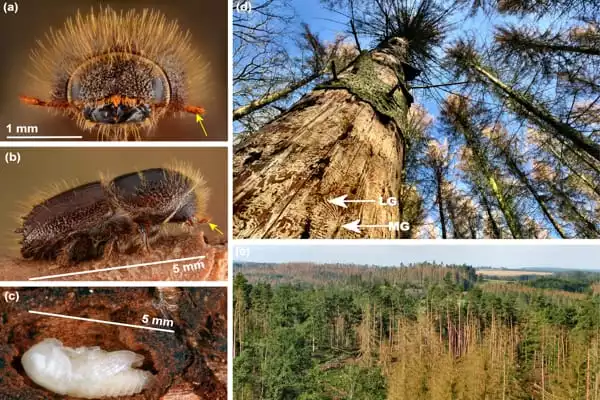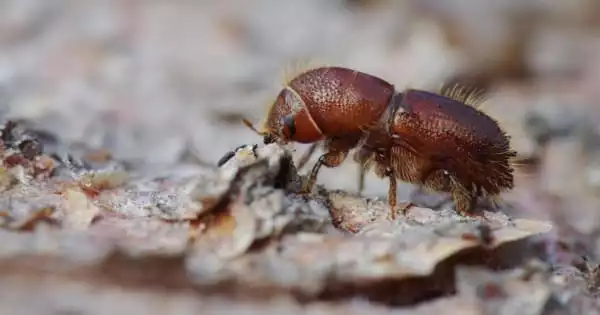A new study reveals a complete mapping of the Eurasian spruce bark beetle genome. The successful mapping allowed the experts to learn more about the most effective pest control options for bark beetles. The recent findings could help to find a solution that will prevent the destruction of over 100 million cubic meters of spruce forests in Europe and Asia caused by the presence of bark beetles.
The entire genome of the Eurasian spruce bark beetle has been successfully mapped. The discovery opens the door to new research into bark beetles and improved prospects for effective pest control of a species that can destroy more than 100 million cubic meters of spruce forest in Europe and Asia in a single year.
The attempt to map the genome information of bark beetles is critical for understanding how the Eurasian pests became one of the most destructive species in lush forests. This also explains why the species was able to conquer vast spruce regions on both the European and Asian continents.
The entire genome of the Eurasian spruce bark beetle has been successfully mapped. It provides a much more in-depth understanding of how and why it has become such a successful forest pest.
Martin N. Andersson
Mapping the genome of the Eurasian spruce bark beetle provides a much more in-depth understanding of how and why it has become such a successful forest pest. Among other things, the genome analysis revealed that the Eurasian spruce bark beetle has an unusually large number of genes that aid in the breakdown of plant cell walls. It, on the other hand, does not appear to have an increased number of genes that allow it to rid its body of foreign substances, which is surprising given that the resin in the trees is toxic to the insects.
The recently completed genome sequencing of the Eurasian spruce bark beetle, Ips typographus, could pave the way for highly specific pest control using RNA interference (RNAi).
The study found that the Eurasian bark beetle has a large number of genes. The majority of these genes is required for species activities and commonly assists them in penetrating various types of materials found in spruce forests, such as plant cell walls. However, the research stated that the bark beetles’ abundant gene pool comes at a high cost, as there is no single gene present in the animals that could help them withstand and repel foreign substances that could potentially harm them. Even common tree resins, for example, have been discovered to be toxic to bark beetles.

RNAi is a molecular biology tool that specifically suppresses the expression of a gene with high precision by injecting double-stranded RNA into the insect, for example, through food. This eventually causes protein production from the corresponding gene to temporarily halt or decrease, without causing any changes to the genome. The method can provide precise information about the roles of specific genes in the biology of the bark beetle, a process that has been aided by the sequencing of the beetle’s entire genome.
The bark beetles, also known as Ips typographus, have had their entire genome extracted for detailed analysis and the development of effective pesticides to save Eurasia’s remaining spruce forests. To create the pesticides, scientists will use the genetic expressions gathered from the bark beetle and combine them with RNA interference, or RNAi.
It is hoped that in the future, the RNAi method will also be useful for practical pest control in forests. “For example, you could suppress genes that have a direct effect on survival, or you could focus on genes that are important for bark beetle reproduction or their ability to perceive the pheromones used for mating and attacking spruce forests,” says Martin N. Andersson, associate professor at Lund University.
The genome-based method is species-specific, which means it has no negative or harmful side effects on other organisms. “Many other important species of the same bark beetle genus, Ips, can be found in North America. The genome of the Eurasian spruce bark beetle will serve as a supplement to help Americans study their own indigenous species” says Fredrik Schlyter, professor at the Swedish University of Agricultural Sciences, SLU.
The researchers conducted sibling mating over ten generations of beetles in the laboratory to study the genome of the Eurasian spruce bark beetle. This was done in order to obtain homogeneous DNA with few variations. The DNA was then extracted from approximately 100 beetles. This was biochemically sequenced in small sections, which were then assembled using advanced computing.
The researchers then compared the results to the genomes of other insects to determine which genes in the Eurasian spruce bark beetle had expanded and which had shrunk in comparison to other closely related species. The genome, according to the researchers, is of very high quality and comparable to some of the best-studied genomes of other insect species such as the fruit fly and mosquito.





